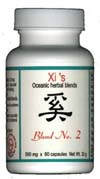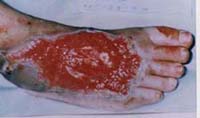|
| |
Dr. Xi's Blend
#2 is a powerful angiogenesis
|

|
After two weeks
of Blend #1, infection has subsided, then change to Blend #2.
To support skin
closure, use 6-8 capsules per day until the condition is improved.
Don't
underestimate it by its mild reaction, its long lasting cumulative
residual effect can last for a week.
|
|
Prophyra
denitmarginata, Typha Angustata, Scutellario baiealensis, Ostrea
rivularis, Siegesbeckia orientalis, Phellodendrom chiennse.
Depending on the
sizes and depth of the lesion, and the circulatory conditions. The dosage
may be adjusted to accelerate the healing.
This patient on the
left stayed on #2 therapeutic formulas for almost 5 months. |
2 weeks into the
treatment

Growth of
tissue is noted most clearly at the peripheral of the lesion. |
|
Increase in bowel
movement may be expected.
|
|
In milder
infection cases; Blend 2, can be
used alone or in conjunction with Blend 1 (morning Blend 1, evening
Blend 2). It stimulates angiogenesis of collateral arteries, clears the
embolus and stimulates the growth of the granulate tissues. Use this
blend during the entire time when open ulcers are present until the
granulate tissue is flush to the level of the original skin and the
ulcers are closed. In larger size lesions, double or triple the dosage
can expedite the speed of healing.
|
|
Blend
2 is also useful to people who is not diabetes but only suffers from
narrowing or obstruction of cardiovascular system, such as varicose
vein, venous stasis, atherosclerosis, angina, post CVA and other
Vascular disorders. It enhances the benefits of CHELATION therapy, yet it does not bind to calcium or
other minerals that
may cause sometimes dangerous prolonged bleeding time.
(This
is NO oral chelation substitutions as in other informercial.) |
|
The clinical
problem of diabetic foot ulcers is undeniably important. The cost of
care of a diabetic foot ulcer is estimated to be nearly USD$5,000 per
episode. In addition to the losses to individual patients in terms of
mobility and quality of life. Losses to society in terms of lost
productivity and wages are difficult to quantify.
There are 4% of US
population diagnosed with some degree of diabetes, (16 millions). 10-15%
of patients with diabetes may be at risk for the development of foot
ulcers. The risk increases in those who smoke, are over 40 years of age,
have hyperlipidemia, or are obese.
There are 50,000
to 60,000 amputations preformed in patients with diabetes each year in
the United States. Nearly half of all patients who undergo amputation
will develop limb-threatening ischemia in the opposite limb within 18
months of amputation and more than half will have an amputation of the
opposite limb within 5 years. |
|
42
days into the treatment
Continuous on blend #2 |
|
Deficiency of
blood supply depends on different age, and organs, it manifests in
different symptoms. In general it shows as paleness, fatigue, weak,
lost of functions and rapid aging. In the heart it shows as angina,
and heart attack. In the brain it shows as stroke, thus lost function
of brain cells, in muscle results fatigue, in skin causes skin
ulceration.
Deficiency of
blood supply is most often caused by the narrowing of blood
vessels. Atherosclerosis is a generic term covering a number of
diseases of the blood vessels. The most frequent causes of
atherosclerosis are cigarette smoking, elevated blood cholesterol,
elevated blood pressure, diabetes, obesity, lack of exercise,
excessive stress, age, gender, and family history.
Ulcers do not
only happen in diabetic patients, there is no histopathologic
difference between diabetic and non-diabetic artherosclerotic lesions,
but the incidence of atherosclerosis is higher in diabetics than in
non-diabetics.
PVD (Peripheral
vascular disease) has been estimated to occur 11 times more frequently
and to develop about 10 years earlier in diabetics than in
non-diabetics. Gangrene is approximately 50 times more frequent in
diabetic men than non-diabetic men over the age of 40, and 70 times
more frequent in women in the same age group.
|
Signs of compromised
blood circulation:
-
Reduction or
absence of pulses. Cold feet and numbness. Skin may be dry and scaly
with poor nail and hair growth.
-
Intermittentclaudiction:
-
Pain ache,
cramp or tired feeling that occurs on walking most commonly in the
calf but also in the foot, thigh, hip or buttocks. It is relieved
quickly (usually in less than 1 or 2 min. by rest, where one can
walk the same distance again before the pain recurs.
-
Rest pain
begins in the most distal parts of the ischemic limb and is a
severe, unrelenting pain aggravated by elevation and often
preventing sleep. To obtain relief, the patient will hang his foot
over the side of the bed or will rest in a chair. Severely ischemic
leg may be shrunken and atrophic. More extensive condition may
compromise the viability of tissues and lead to necrosis or dry
gangrene; if venous congestion is also present, infection or wet
gangrene may develop. As the condition worsens, ulceration may
appear, especially after local trauma (scratch, cuts, inset bites,
blister etc.).
|
Home Page How to use Dr. Xi's formulas
instructions
Blend #1
Blend #2
Blend #3
|